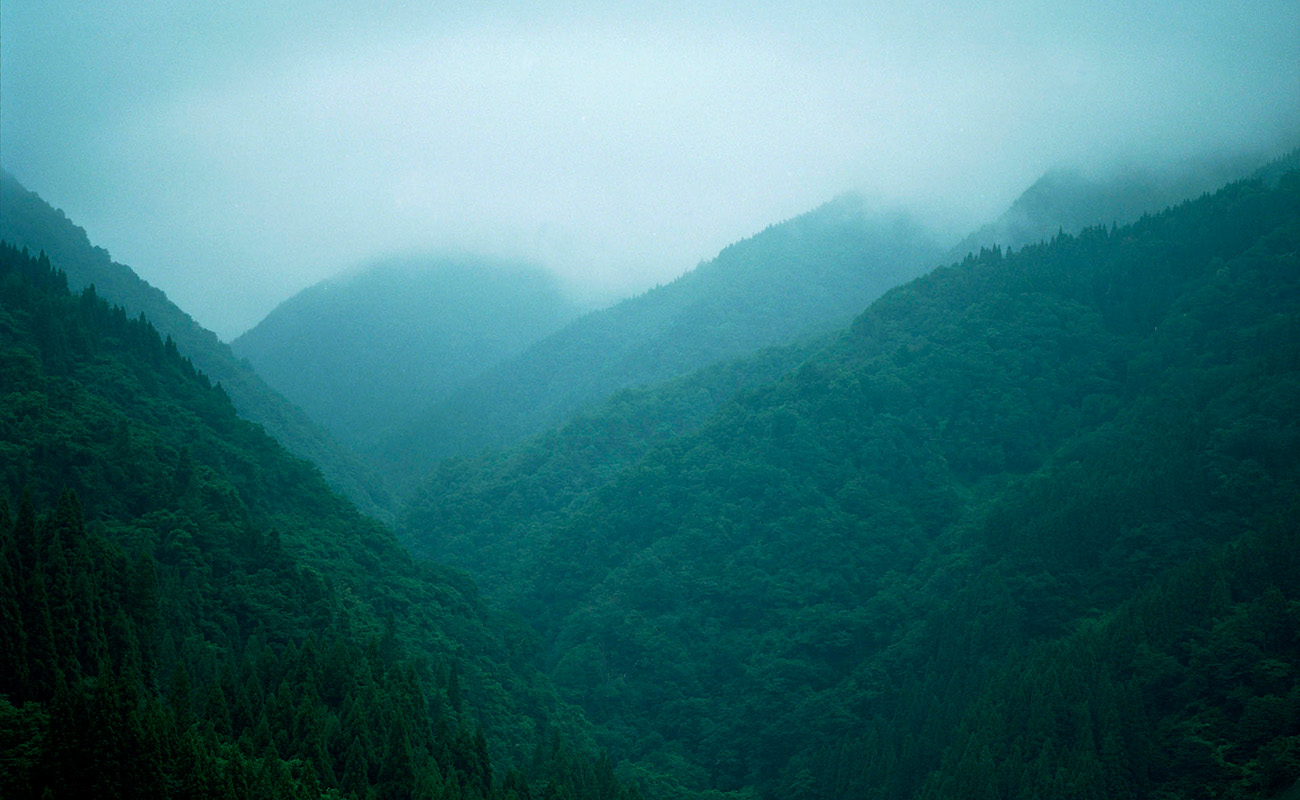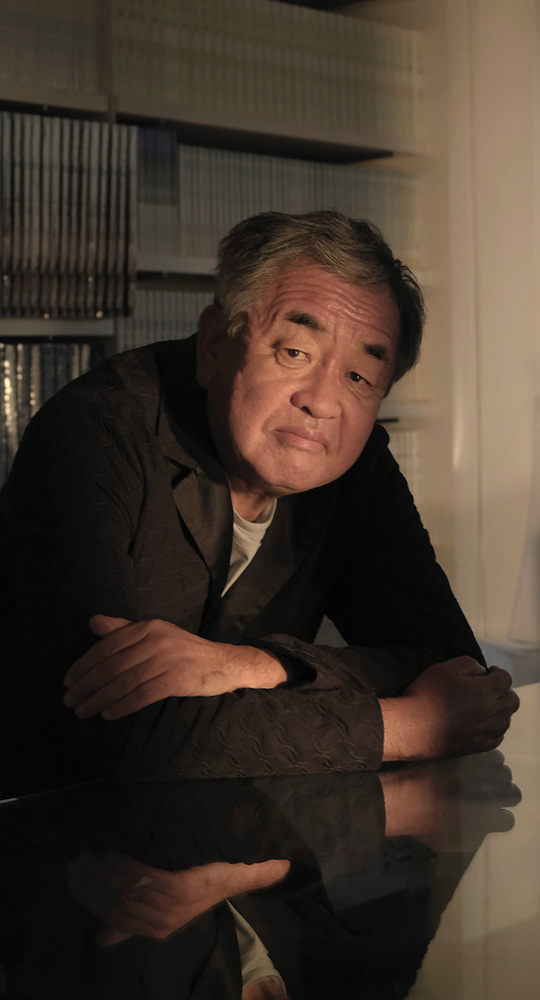
広川泰士『南砺』シリーズより
アフター・コロナ、地球に住む人類は、「歴史を折り返す」生き方が求められています。
サスティナブルな未来のために、日本が世界に提供できる価値観はあるでしょうか?
あるとしたら、それはどのようなことでしょうか?
隈|
日本人は永きにわたり自然を敬い、畏れ、自然と共に暮らしてきました。季節の移り変わりを愛で、変化を受け入れ、順応することで、内と外を分断することなく、一連の繋がりとして捉えてきました。日本人の文化、とりわけ空間に対する考え方には、これからの時代の新しい価値観を生み出す上で多くのヒントが潜んでいます。
自然と共に生きる暮らしを取り戻すためには、僕はこうした様々な小さなヒントを建築空間の中に反映させ、大きなスケールの中で再現していこうと考えています。
具体的には?
隈|
日本家屋には現代建築が取り入れるべき、多くの概念があります。たとえば「縁側」は、建物のヘリ部分を張り出しで設けられる板敷状の通路ですが、庭から直接屋内に上がる用途もあります。この空間は内でも外でもなく、両者を繋ぐ機能も果たしています。
さらに「軒」は、奥行きが深く、建造物の陰影を際立て、風通しを良くすると同時に雨風をしのぎ、外壁を守る用途を果たしています。こうした意匠は、建築に独特の印象を与えています。
僕は、海外プロジェクトのプレゼンでは、「縁側」は「ENGAWA」、「軒」は「NOKI」、「木漏れ日」は「KOMOREBI」とし、日本語をそのまま用いて説明しています。
訳せないという意味ですか?
隈|
そうです。建築部位の説明だけでは不十分です。そこには明確な機能もあり、日本の美意識も反映されているからです。僕らはそれらを丁寧に語り、日本文化が生み出した建築技法として理解してもらっています。光についてのイメージ「木漏れ日」については「KOMOREBI effect」とし、大きな光が小さな光、優しい光となることを説明してきました。
小さく、優しい印象の空間は、日本が継承してきた美意識や丁寧な暮らしの作法によって磨かれてきた価値です。「歴史の折り返し点」に立つ今、世界が注目する木造建築には多くの可能性があると同時に循環があります。
木と土地は繋がっている。そこに芽生え、育った木を使って建築をつくっていくことは幸せな循環です。日本の国土面積にしめる森林率は約7割、先進国中で有数の森林大国です。
保水力のあるいい山で育った森の木を使い、木という大地の恵みと繋がった暮らしを取り戻すことは、世界に対する確かなメッセージとなるはずです。



無いものねだりをするのではなく、自分の身の回りにある、自然からの恵みを日々感じ環境を取り戻すことから始めるという選択ですね。
最後に、現在取り組まれている公共空間についてお聞かせください。
隈|
福島県浪江町の浪江駅周辺整備計画です。2011年の大震災によって被災した町民の多くはこの地から離れてしまいましたが、この町に戻りたくなる駅周辺エリアをみなさんと共に創ってゆきたいと思っています。

After Coronavirus, human beings living on Earth will be required to live a life that ‘turns back history’. Are there any values that Japan can provide to the world for a sustainable future? If so, what would they be?
KK|
Japanese people have long respected, feared and lived with nature. By loving the changing of the seasons, accepting these changes and adapting to them, they are seen as a series of connections without dividing the inside and outside. Japanese culture, especially the way of thinking about space, has many hints for creating new values for the future.
In order to return to living in coexistence with nature, I intend to reflect these various small hints in my architectural space and reproduce them on a large scale.
Specifically?
KK|
Japanese houses have many concepts that modern architecture should incorporate. For example, the ‘Engawa’ (a veranda-style porch) is a passage that overhangs the edge of the building, but it can also be used to go indoors directly from the garden. This space is neither inside nor outside, yet it also functions to connect the two. In addition, the ‘Noki’ (eaves) are deep and have the purpose of highlighting the shadows of the building, improving ventilation, as well as keeping out the rain and wind and protecting the outer wall. These designs give the architecture a unique impression.
In presentations for overseas projects, I use ‘ENGAWA’ for veranda, ‘NOKI’ for ‘eaves’, and ‘KOMOREBI’ for sunbeams. I explain them using the original Japanese.
Does that mean they cannot be translated?
KK|
That’s exactly it. An explanation of the building parts is not enough. They also have clear functions and reflect the aesthetic sense of Japan. We carefully explain and make sure they understand them as an architectural technique created by Japanese culture. I explain the image of ‘Sunbeams through the trees’ as the ‘KOMOREBI effect’, explaining that large light becomes small light and gentle light.
A small, gentle space is a value that has been refined by the aesthetic sense and polite way of life inherited by Japan. Now that we are at a ‘turning point in history’, the wooden architecture that the world is paying attention to has many possibilities and cycles. The trees and land are connected. It’s a blissful cycle to build using trees that sprout and grow in that location. The forest to land ratio in Japan is about 70% forest, making it one of the leading forest powers among developed nations.
Using forest trees grown in mountains with good water retention, returning to a way of life connected to these blessings of the earth, the trees. This should be a strong message to the world.



Indeed, rather than asking for the impossible, you can choose to feel the blessings of nature around you every day.
Finally, could you tell us about the public spaces you are currently working on?
KK|
An improvement project around Namie Station in Namie Town, Fukushima Prefecture. Many of the residents who were affected by the 2011 Great East Japan Earthquake have left the area, but I would like to work with everyone to create an area around the station that makes people want to return to the town.